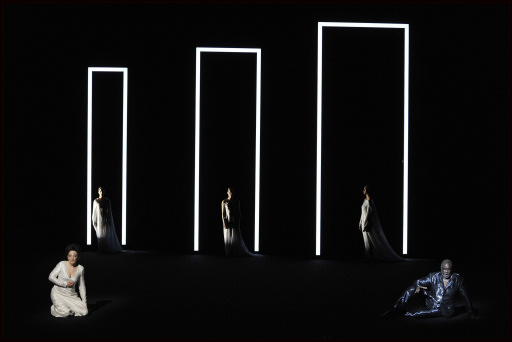Other Links
Editorial Board
-
Editor - Bill Kenny
-
Deputy Editor - Bob Briggs
Founder - Len Mullenger
Google Site Search
SEEN AND HEARD INTERNATIONAL OPERA REVIEW
Bartok,
Le Château de Barbe-Bleue: New production by Jean-Paul Scarpitta,
Soloists and orchestra of the Opéra National de Montpellier, Alain Altinoglu
conductor. Montpellier, France. 27.4.209 (MM)

A major challenge of presenting Bela Bartok's Bluebeard's Castle is
making it part of a full evening. Though the work is huge musically and
emotionally, it clocks in at just under an hour. It is therefore what opera
impresarios consider a one-act that must be complemented by an additional
one-act so that audiences will feel they have gotten their money's worth.
There can be no question that Bluebeard's Castle will tower over whatever
may be paired with it. Solutions as to what works best are varied. The Los
Angeles Opera sidestepped the problem by putting it together with Gianni
Schicchi. Then there was the German house that simply performed it once
and then performed it again. Maybe the best solution is to let it stand by
itself as it well fills an evening - there will be little disagreement that its
thematic, dramatic and musical brilliance fully satisfy the operatic appetite.
To avoid clashing musical styles Bluebeard's Castle can be paired with a
Bartok ballet for example, to act as an overture to this much bigger
work. And there is the solution chosen by the Opéra National de Montpellier -
program a work that serves as an introduction to Bartok's enigmatic exploration
of sexual politics. This work was a bit of operatic trivia, something called
Sancta Susanna, one of the three small erotic operas composed by Paul
Hindemith in the early 1920's that Hindemith himself later withdrew from his
oeuvre.
Susanna is a nun whose erotic feelings are awakened by the sounds of a May
night, and by the virile body of the Man hanging on the cross, his loin cloth
ecstatically removed to consummate the scene. All this was ever-so-tastefully
staged frontal nudity by Montpellier's "artiste en résidence," Jean Paul
Scarpitta. While Richard Strauss justifies his Salome with his famous
putrid chord, Hindemith primly continues with his flaccid modernized
neo-romanticism to the end, leaving a feeling of disgust that such an opera,
however brief, even exists (see above that Hindemith too may have agreed).
We were thereby fully advised that Jean Paul Scarpitta's mise en scène of
Bluebeard's Castle was to be about the awakening and consummation of
erotic urges. Bartok and Scarpitta were joined by conductor Alain Altinoglu,
mezzo soprano Nora Gubisch and bass baritone Willard White to realize the
successive revelations that lead to Judith's passage into womanhood, and that
they did with artistic bravado.
Scarpitta used an immense black stage space as the nocturnal castle, its
inhabitant a black suited black man of quiet primal power, and its ingénue a
white gowned woman who vibrantly passed from door to door, and finally passed
through the last one. Illuminated white shapes, door's frames, floated
ceaselessly through the space, interrupted by bars of red light, strips of blue
lights, sometimes bars and strips of yellow and green lights to mark the
appearance of each new vista, though objective images of any of these existed
only in musical essence.
Mo. Altinoglu, Montpellier's principal guest conductor, painted Bartok's surreal
world with infinite colors, working with his singers costumed in abstracted,
almost concert dress to create an essential metaphysical world, in fact a
musical world, physically nuanced only by the minimal if continuous movements of
its actors. But each movement, no matter how minimal, a finger lifted for
example, a hand held out to accept an imaginary key, was carefully
choreographed, as was the 'irreale' slowness of the copulation (manqué ou pas)
and the final passage (though these final actions were not at all based on the
minimal movements of concert performance). Scarpitta found the exact delicate
balance of music and vision to create the magic of this archetypical dream
world.
Mme. Gubish was the focus of the Scarpitta production, the text carefully
delivered with vocal and histrionic mastery. Mr. White is much appreciated as a
Bluebeard; here his usual careful singing and musicianship merged seamlessly
into the darker recesses of the stage picture. The Orchéstre National de
Montpellier reveled in the opportunity to perform this orchestral masterpiece,
the openness of the Opéra Berlioz' pit revealing a transparency of tone that we
miss in the Opéra Comedie [Montpellier's nineteenth century opera house].
The production was a technical feat, the continuously choreographed
upward-downward, onstage-offstage movements of the doors and strips surely
required an army of technicians and precise stage management. Unfortunately
these technicians did not share in the applause, though Mr. Scarpitta did take a
well-deserved bow at this third and final performance, as the lighting designer,
Urs Schönebaum should have done too.
Michael Milenski
Picture © Marc Ginot / Opéra National de Montpellier
Back
to Top
Cumulative Index Page
